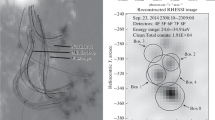Abstract
A recent discovery from the Big Bear Solar Observatory has linked the cancellation of opposite polarity magnetic fragments in the photosphere (i.e., so-called cancelling magnetic features) to X-ray bright points and has stimulated the setting up of a converging flux model for the process. Cancelling magnetic features can occur between magnetic fragments of differing strengths in many different situations. Here, therefore, we model two opposite polarity fragments of different strengths in the photosphere by two unequal sources in an overlying uniform field. Initially in thepre-interaction phase these sources are assumed to be unconnected, but as they move closer together theinteraction phase starts with an X-type neutral point forming, initially on the photosphere, then rising up into the chromosphere and corona before lowering back down to the photosphere. Thecapture phase then follows with the sources fully connected as they move together. Finally, after they come in to contact, during thecancellation phase the weaker source is cancelled by part of the stronger source. The height of the X-type neutral point varies with the separation of the sources and the ratio of the source strengths, as do the positions of the neutral points before connection and after complete reconnection of the two sources. The neutral point is the location of magnetic reconnection and therefore energy release which is believed to power the X-ray bright point in the corona. By using a current sheet approximation, where it is assumed no reconnection takes place as the two sources move together, the total amount of energy released during reconnection may be estimated. The typical total free magnetic energy is found to be of the order of 1020–1021 J, which is as required for an X-ray bright point. It is also found that, as the ratio of the source strengths increases, the height of the X-type neutral point decreases, as do the total energy released, and the lifetime of the bright point.
Similar content being viewed by others
References
Dere, K. P.: 1993,Proc. 2nd SOHO Workshop, Elba, ESA, in press.
Golub, L., Krieger, A. S., and Vaiana, G. S.: 1976a,Solar Phys. 49, 79.
Golub, L., Krieger, A. S., and Vaiana, G. S.: 1976b,Solar Phys. 50, 311.
Golub, L., Krieger, A. S., Silk, J., Timothy, A., and Vaiana, G. S.: 1974,Astrophys. J. 189, L93.
Golub, L., Krieger, A. S., Harvey, J., and Vaiana, G. S.: 1977,Solar Phys. 53, 111.
Harvey, K. L.: 1984,Proc. 4th European Meeting on Solar Physics, ESA SP 220, p. 235.
Harvey, K. L.: 1985,Australian J. Phys. 38, 875.
Hu, Y. Q. and Low, B. C.: 1983,Solar Phys. 84, 83.
Martin, S. F.: 1984, in S. Keil (ed.),Small-Scale Dynamical Processes in Stellar Atmospheres, Sacramento Peak Observatory, p. 30.
Martin, S. F.: 1986, in A. Poland (ed.),Coronal and Prominence Plasmas, NASA CP 2442, p. 431.
Martin, S. F.: 1988,Solar Phys. 117, 243.
Martin, S. F.:, Livi, S. H. B., Wang, J., and Shi, Z.: 1984, in M. Hagyard (ed.),Measurements of Solar Vector Magnetic Fields, NASA CP 2374, p. 403.
Priest, E. R., Parnell, C. E., and Martin, S. F.: 1994,Astrophys J., in press.
Shibata, K., Ishido, Y., Acton, L., Strong, K., Hirayama, T., Uchida, Y., McAllister, A., Matsumoto, R., Tsuneta, S., Shimizu, T., Hara, H., Sakurai, T., Ichimoto, K., Nishino, Y., and Ogawara, Y.: 1992,Publ. Astron. Soc. Japan 44, L173.
Shimizu, T., Tsuneta, S., Acton, L., Lemen, J. R., and Uchida, Y.: 1992,Publ. Astron. Soc. Japan 44, L147.
Vaiana, G. S., Krieger, A. S., Van Speybroeck, L. P., and Zehnpfennig, T.: 1970,Bull. Am. Phys. Soc. 15, 611.
Webb, D. F., Martin, S. E, Moses, D., and Harvey, J. W.: 1993,Solar Phys. 144, 15.
Author information
Authors and Affiliations
Rights and permissions
About this article
Cite this article
Parnell, C.E., Priest, E.R. & Titov, V.S. A model for X-ray bright points due to unequal cancelling flux sources. Sol Phys 153, 217–235 (1994). https://doi.org/10.1007/BF00712503
Received:
Revised:
Issue Date:
DOI: https://doi.org/10.1007/BF00712503




